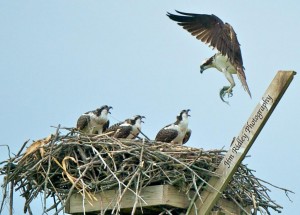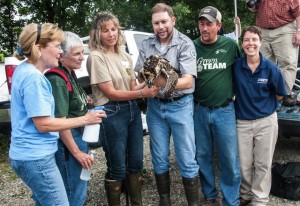There are 50 breeding osprey pairs in southern Michigan, up from a single nest some two decades ago.
That’s seven years ahead of a goal to have 30 pairs in the area. And the birds are on the move.

Monroe Spark and his siblings wait for the arrival of a meal. Photo: Jim Ridley
One of the Michigan birds, named Monroe Spark, recently reached Cuba.
For the first time in Michigan, ospreys were fitted this past summer with transmitters to research where they migrate.
“The word is out for the birders down there to watch for him,” said Barb Jensen, a founding member of the Osprey Watch of Southeast Michigan. The group is a volunteer organization whose goals are to help restore osprey to southeast Michigan and to educate the public about the bird.
The other two are in Florida and South America.
Beyond trying to determine migration routes, Jensen says that tracking the birds is a huge opportunity for educational outreach. The program tracks the birds’ migration on a website that students can access.
“We see a disconnect with kids and nature. This is a way for us to keep kids engaged using devices they are familiar with.”
The migration routes of the three osprey fitted with transmitters can be followed online at the Osprey Watch of Southeast Michigan’s website.
Funding for the tracking devices and help installing platforms for the birds to nest on in the Detroit River International Wildlife Refuge came from DTE Energy and the American Tower Corp. Additional support came from the Michigan Department of Natural Resources, the Detroit Zoological Society and U.S. Fish and Wildlife Services.

Crew members at the Detroit River International Wildlife Refuge who worked together to make relocation and tracking possible. Left to right: Barb Jensen, Roberta Urbani, Julie Oakes, Brian Washburn, Jason Cousino and Sara Woodhouse. Photo credit: Jane Purslow
“It’s been a wonderful partnership,” said Jensen. “This was really an all out effort.”
Monroe Spark was born in early June of this year on an osprey platform in the refuge near Estral Beach. Now fully grown, the male bird has a wingspan of 5 to 6 feet.
John Hartig, manager of the Detroit River International Wildlife Refuge, says that he is thrilled to be part of this effort.
“Ospreys were gone for a long time. In the past ten years or so they started bouncing back a little,” he said.
“This ecological recovery story is just amazing. How heartening is that for this region?”
Excellent! We applaud your efforts!